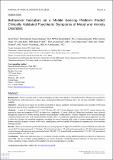Behavioral Indicators on a Mobile Sensing Platform Predict Clinically Validated Psychiatric Symptoms of Mood and Anxiety Disorders
Author(s)
Place, Skyler; Blanch-Hartigan, Danielle; Rubin, Channah; Gorrostieta, Cristina; Mead, Caroline; Kane, John; Marx, Brian P; Feast, Joshua; Deckersbach, Thilo; Nierenberg, Andrew; Azarbayejani, Ali; Pentland, Alex Paul; ... Show more Show less
DownloadBehavioral indicators.pdf (705.0Kb)
PUBLISHER_CC
Publisher with Creative Commons License
Creative Commons Attribution
Terms of use
Metadata
Show full item recordAbstract
Background: There is a critical need for real-time tracking of behavioral indicators of mental disorders. Mobile sensing platforms that objectively and noninvasively collect, store, and analyze behavioral indicators have not yet been clinically validated or scalable.
Objective: The aim of our study was to report on models of clinical symptoms for post-traumatic stress disorder (PTSD) and depression derived from a scalable mobile sensing platform.
Methods: A total of 73 participants (67% [49/73] male, 48% [35/73] non-Hispanic white, 33% [24/73] veteran status) who reported at least one symptom of PTSD or depression completed a 12-week field trial. Behavioral indicators were collected through the noninvasive mobile sensing platform on participants’ mobile phones. Clinical symptoms were measured through validated clinical interviews with a licensed clinical social worker. A combination hypothesis and data-driven approach was used to derive key features for modeling symptoms, including the sum of outgoing calls, count of unique numbers texted, absolute distance traveled, dynamic variation of the voice, speaking rate, and voice quality. Participants also reported ease of use and data sharing concerns.
Results: Behavioral indicators predicted clinically assessed symptoms of depression and PTSD (cross-validated area under the curve [AUC] for depressed mood=.74, fatigue=.56, interest in activities=.75, and social connectedness=.83). Participants reported comfort sharing individual data with physicians (Mean 3.08, SD 1.22), mental health providers (Mean 3.25, SD 1.39), and medical researchers (Mean 3.03, SD 1.36).
Conclusions: Behavioral indicators passively collected through a mobile sensing platform predicted symptoms of depression and PTSD. The use of mobile sensing platforms can provide clinically validated behavioral indicators in real time; however, further validation of these models and this platform in large clinical samples is needed.
Date issued
2017-03Department
Massachusetts Institute of Technology. Media LaboratoryJournal
Journal of Medical Internet Research
Publisher
Gunther Eysenbach, JMIR
Citation
Place, Skyler; Blanch-Hartigan, Danielle; Rubin, Channah; Gorrostieta, Cristina; Mead, Caroline; Kane, John; Marx, Brian P et al. “Behavioral Indicators on a Mobile Sensing Platform Predict Clinically Validated Psychiatric Symptoms of Mood and Anxiety Disorders.” Journal of Medical Internet Research 19, no. 3 (March 2017): e75 © 2017 Place et al
Version: Final published version
ISSN
1438-8871